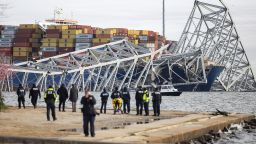When a container ship slammed into Baltimore’s Francis Scott Key Bridge on Tuesday, it led to the disastrous collapse that left six people presumed dead and took out one of the region’s key infrastructure links.
But it wasn’t the first time that kind of impact had happened: Four decades earlier, another container ship that also lost power hit the same bridge – and it stood strong.
The drastic difference in outcomes between the two accidents is an example of the dangers caused by the massive increase in shipping vessel size in the intervening decades. It’s also raising questions about whether changes in the bridge’s design could have prevented the deadly collapse.
A CNN review of public records and interviews with about a dozen bridge and shipping experts show that hundreds of bridges over US waterways were built decades ago when container ships were a fraction of the size and weight they are today. Bridges of the era when the Key Bridge was built weren’t designed to protect against collisions with ships as big as the Dali, the vessel that caused the Baltimore catastrophe.

Some experts said that this week’s disaster should inspire engineers to reevaluate whether America’s aging infrastructure can withstand impacts from the gigantic ships that transit our waterways today.
“It’s absolutely a wake-up call,” said Rick Geddes, a professor and director of Cornell University’s Program in Infrastructure Policy. “The people who were building the Francis Scott Key Bridge never really contemplated ships of this size. It wasn’t their fault – they just didn’t have a crystal ball.”
Ships are getting bigger, heavier
The previous Key bridge accident had eerie similarities to what happened on Tuesday. In August 1980, a Japanese container ship crossing the Baltimore harbor lost propulsion about 600 yards from the Key Bridge after its electrical control board shorted out in the early morning hours. The ship then crashed into the bridge, colliding with one of its piers, according to a National Research Council report on ship-bridge collisions.
The collision ripped out a 30-foot section of a protective structure around the bridge’s concrete piling, according to a 1981 article published in The Evening Sun newspaper that cited a Coast Guard report on the incident. But the piling itself was only chipped, not significantly damaged. The accident caused $500,000 in damage to the bridge and required $350,000 in ship repairs, the Sun reported.
Experts said it’s highly unlikely the damage from the 1980 incident was related to its collapse. Inspections in recent years had found the bridge to be in “fair” condition, according to federal data, and Maryland Gov. Wes Moore said Tuesday it was “fully up to code.”
One major difference between the two accidents was the size of the ship. Data from the maritime tracking website MarineTraffic suggests the ship that crashed into the bridge in 1980, then known as Blue Nagoya, was about a third of the length and a fraction of the weight of the Dali.
That’s not surprising given the explosion in the size of container ships in recent decades. Container ships in the 1970s – when the Key Bridge was built – could only typically carry about 2,500 twenty-foot equivalent units of cargo, according to research by Jean-Paul Rodrigue, a maritime business administration professor at Texas A&M University-Galveston.
But in the wake of a major project to expand the Panama Canal that was completed in 2016, ports on the east coast of the United States can handle ships with six times as much cargo as that. The Dali has a capacity of about 10,000 twenty-foot equivalent units – so even larger ships serve the Baltimore port.
In addition to the difference in size, the Blue Nagoya was moving at a speed of six knots, according to the National Research Council report, while the Dali was moving at eight knots, Maryland’s governor said. A larger ship moving faster would have created far more force on the bridge, experts said.
Outdated bridge protections no match for massive modern vessels
Experts said the 1980 incident also raised questions about whether the Key Bridge should have added additional protective structures around its structural piers.
The National Research Council report on ship-bridge collisions compiled in 1983 noted that at the time, the bridge had concrete “protection devices” that were “fendered with timber” – meaning that timber structures were installed around the pier to protect it. The report also said it had a “crushable protective structure” to limit the force applied to its pier in the event of a collision, which “proved effective in absorbing a direct collision” when the Japanese ship struck it.
It’s unclear whether the protective structure was rebuilt after that incident, or if the Key Bridge had any kind of fenders before yesterday’s collapse. Several experts said there are no obvious fenders visible in photos of the bridge, and the Maryland Transportation Authority did not immediately respond to a question about the bridge’s design.
The bridge is surrounded by several “dolphins” – concrete structures that are intended to slow or deflect oncoming vessels – which may be the protective structures the report referred to. The Dali appears to have hit the bridge at an angle that narrowly avoided a dolphin.

Because the dolphins are relatively small and leave various angles unprotected, “what was put in place appears to be definitely not the most optimal way to do it,” said Hussam Mahmoud, a Colorado State University engineering professor. After the 1980 collision, he argued, more substantial dolphins or a fendering system should have been added to the Key Bridge.
The Key Bridge’s dolphins were once seen as the latest innovations in bridge design: After the Sunshine Skyway Bridge over Tampa Bay collapsed in 1980, killing 35 people, some observers noted the then-new Key bridge’s use of dolphins. Florida officials had considered duplicating them for the Sunshine Skyway but decided against it, according to an article in the Tampa Tribune that year.
Rod Sullivan, a longtime maritime attorney in Florida, said the Tampa disaster led to changes in bridge construction techniques, including the addition of fenders in many new bridges built after 1980.
“You don’t ever want a ship to actually touch the support of the bridge,” he said. “You knock out one of the support posts, the entire bridge collapses.”
The Key Bridge is hardly unique among large bridges in its age. Nationally, there are at least 300 bridges in the US that are over waterways and have a vertical clearance of more than 100 feet (though large ships don’t necessarily pass under all of them). Two-thirds of them were built before 1980, according to a CNN analysis of data from the Federal Highway Administration’s National Bridge Inventory, and a third are listed as having been reconstructed since then.
Some other bridges that cross major shipping routes are designed with more extensive protections than the Key Bridge’s. The Verrazzano-Narrows Bridge at the entrance to the New York Harbor and the Arthur Ravenel Jr. Bridge in Charleston, South Carolina, for example, both have large rock islands surrounding their piers that are designed to stop approaching ships.
Others, such as Savannah’s Talmadge Memorial Bridge and Los Angeles’ Vincent Thomas Bridge, are designed without support pillars in the middle of the waterways they cross – although the Key Bridge covers a much longer distance.
In the wake of the Key Bridge collapse and with the rise of larger container ships, some experts said that engineers should reassess necessary bridge safety features. That could include installing larger fenders “like the bumper of your car that could fend off a big ship like this,” Geddes said.
“There’s a lot of economic benefits” to the increase in container ship size, he said, “but the infrastructure is updated more slowly.”
Some other experts doubted whether any feasible protective structure could have saved the bridge from a head-on strike from a ship as big as the Dali. “No bridge, unless a fortress is built around it, could survive such an impact,” said Barzin Mobasher, an Arizona State University structural engineering professor.
Still, Mobasher said, the fact that the Key Bridge was hit twice by shipping vessels in 40 years shows that engineers should reevaluate their safety models to take necessary precautions. After all, he said, “it could happen again.”
CNN’s Daniel Medina, Majlie de Puy Kamp, and Yahya Abou-Ghazala contributed to this report.










